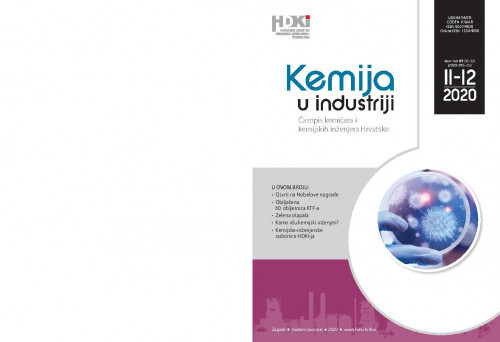Selektivno lasersko sinteriranje (SLS) jedan je od važnijih postupaka 3D ispisa koji se u današnje vrijeme sve više primjenjuju za dobivanje različitih modela. Najvažniji polimerni materijali koji se upotrebljavaju u tom procesu su poliamidi. Značajan nedostatak tog procesa je velika količina otpadnog polimernog praha. Stoga je cilj ovoga rada bio istražiti utjecaj dodatka nanočestica titanijeva dioksida (TiO2) na toplinska i mehanička svojstva otpadnog poliamidnog praha (PA 2200). U ovom radu pripremljeni su nanokompoziti PA/TiO2 u rasponu masenog udjela punila 1 – 5 %, postupkom zamješavanja punila u talinu polimera u gnjetilici Brabender. Aglomerati nanopunila vidljivi su na SEM mikrografiji 5 %-tnog PA/TiO2 nanokompozita. Rezultati diferencijalne pretražne kalorimetrije (DSC) ukazuju na djelovanje nanočestica TiO2 kao heterogenih nukleacijskih centara. Također, dodatak nanopunila pospješuje stvaranje stabilnijih i uređenijih kristalnih struktura poliamidne matrice. Termogravimetrijskom analizom (TGA) dokazano je da dodatak TiO2 nanopunila povećava temperaturu početka razgradnje PA matrice, to jest poboljšava toplinsku postojanost PA matrice i neznatno povećava vrijednosti toplinske vodljivosti nanokompozita u odnosu na čistu polimernu matricu. Ispitivanjem mehaničkih svojstava uzoraka uočeno je smanjenje vrijednosti sekantnog modula te neznatne promjene naprezanja i istezanja u točki popuštanja s povećanjem udjela punila u nanokompozitu.; The PA 2200 waste powder generated during selective laser sintering (SLS) process is an important environmental and economic problem. In order to test and modify the properties of the waste powder, nanocomposites based on polyamide matrix and TiO2 nanoparticles were prepared in this work. Agglomerates of the TiO2 nanofiller are visible on the SEM micrographs for the nanocomposite with 5 wt. % of the nanofiller (Fig. 1). The DSC analysis indicates an increase in crystallization temperature (Tc) by the addition of filler to the polymer matrix and it can be concluded that the TiO2 nanoparticles represent the nucleation centres in the PA matrix (Fig. 2, Table 1). In systems with 4 and 5 wt. % TiO2 crystallization enthalpy (ΔHc) and melting enthalpy (ΔHm) are higher than the values for the polyamide matrix (Table 1), indicating that the nanoparticles promote crystallization of the PA matrix. The results of TG analysis imply a positive effect of the TiO2 nanoparticles on the onset of thermal decomposition, which is most pronounced in the system with 3 wt. % TiO2 (Fig. 3, Table 2). As thermal degradation progresses further, the positive effect of the addition of TiO2 nanoparticles becomes less pronounced and finally becomes negative in the final stages, i.e. TiO2 nanoparticles accelerate the degradation. The thermal conductivity values (λ) are slightly higher for the nanocomposites relative to the pure PA matrix (Fig. 4) due to the formation of a more ordered structure of the polymer matrix by the addition of TiO2 and/or the formation of so-called conductive pathway. The results of the mechanical test indicate that the addition of TiO2 nanofiller decreases the values of the secant modulus (E), while the values of the yield stress (σ2>y</sub) and yield elongation (ε2>y</sub) change slightly relative to the values obtained for the pure polymer matrix (Table 3).
Sažetak

 Kemija u industriji : 69,11/12 (2020) / glavni i odgovorni urednik Nenad Bolf.
Kemija u industriji : 69,11/12 (2020) / glavni i odgovorni urednik Nenad Bolf.